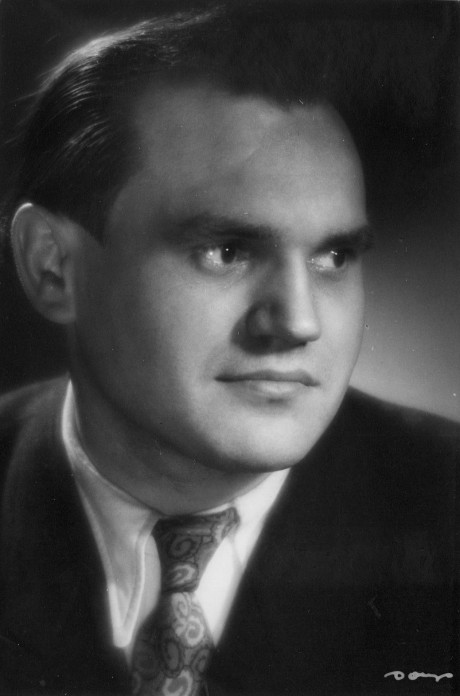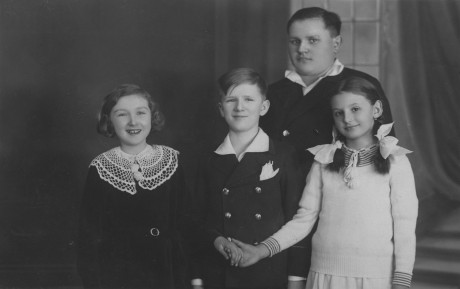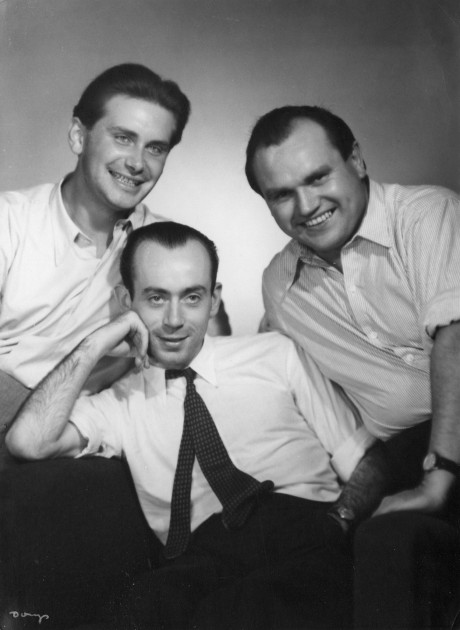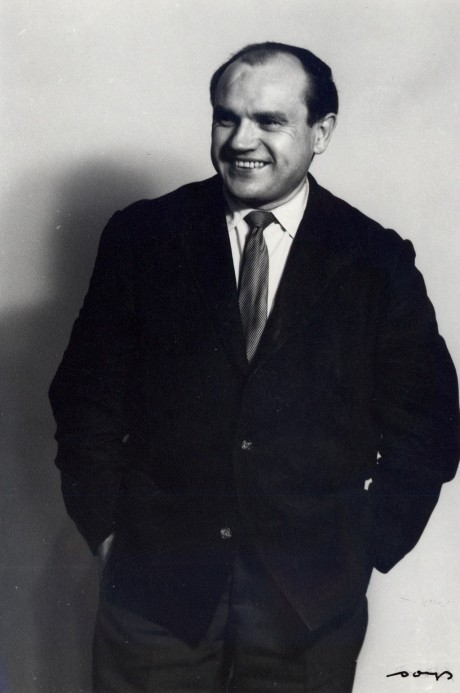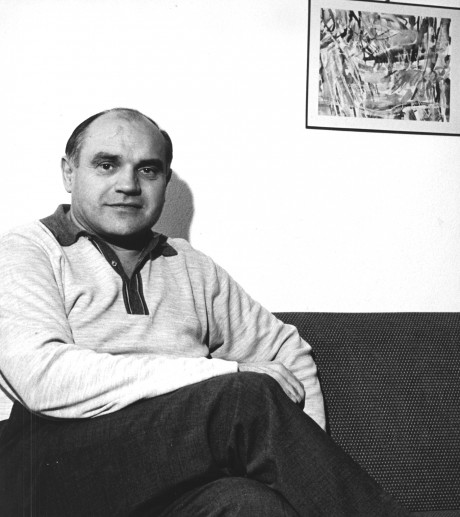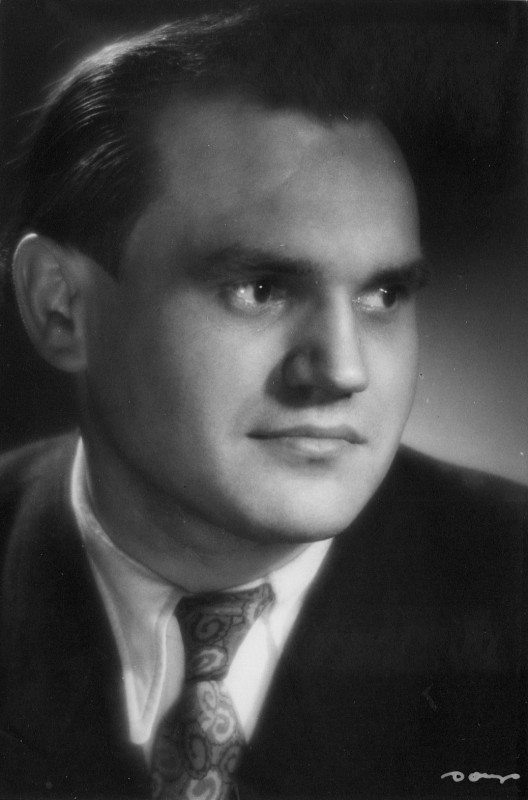Biography
Idyllic childhood and youth in the shadow of war
It was 1935 when Kazimierz Serocki (broń 1922) was photographed with his friends from the Toruń Conservatory. The photograph was taken straight after a concert featuring the young pianists. Serocki is thirteen years old in it. His musical talent was revealed very early, although there were no musical traditions in the Serocki family. But Kazimierz’s parents, whose occupation was trade and crafts, made sure that their children would get a comprehensive education. As soon as they noticed their son’s passion, they decided to support his musical development. As a result, already in 1939 the press commented on Kazio’s performance in a school concert in the following manner:
“The primacy went to the peerless Kazimierz Serocki, who in Beethoven’s Piano Concerto in C minor displayed considerable talent as a pianist as well as full understanding of the style of the work, profound sense of phrasing and mastery of the instrument.”
[Tempo Dnia (21 June 1939), Bydgoszcz]
The outbreak of the Second World War put a stop to this promising career. Yet the seventeen-year-old Kazimierz had no intention of giving up. He moved from his family home (in the mid-1930s the Serockis moved from Toruń to Chełmża and then to Solec Kujawski), located within the territory incorporated into the Third Reich, to German-occupied Warsaw (to the so-called General Government) and began to live on his own. He resumed his musical studies in a clandestine conservatory, but had to make a living as well. So he performed in Warsaw cafes, variety shows and theatres (see theatre poster below) as a pianist, acting as an accompanist, arranger and jazz improviser. In addition, he wrote songs, though only their titles have survived. We know, however, that the songs were appreciated by the public and that Serocki began at that time to seriously contemplate becoming a composer.

First afterwar years and “Group 49”
In the first few years after the second world war Kazimierz Serocki successfully combined the two areas of his artistic activity. He completed his piano and composition studies in Łódź. In 1946 he made his debut as a composer with Concertino for piano and orchestra. At the same time he gave concerts as a pianist, increasingly adding his own compositions to the programmes of the concerts. His basic income came from writing functional music, above all illustrations for films like Chopin‘s Youth directed by Aleksander Ford (1952) – the biggest venture in the history of Polish cinematography thus far, involving 1.5 thousand extras and faithfully recreating life in 19th-century Poland. In 1948 Serocki left for Paris to study with the famous Nadia Boulanger. His stay in the West gave him an opportunity to get to know the twelve-tone technique and works of Béla Bartók, of whom he became a great enthusiast.
After returning to Poland Serocki focused on building his career as a composer – he became a member of the Polish Composers’ Union, being actively involved in the work of the organization. Yet what proved to be the most important factor in his artistic development was the “creative alliance” formed with Jan Krenz and Tadeusz Baird. “Group 49” was an attempt, built on friendship and a desire to provide mutual assistance, to survive the difficult times in which the ideological pressure of socialist realism ruthlessly stifled freedom of creation. Until 1955 Serocki composed mainly folklore-inspired pieces, though he did not avoid having to pay a “tribute” to the authorities in the form of mass songs. However, his defiant temperament and inquiring attitude enabled him to smuggle “formalist” techniques into seemingly “politically correct” compositions, as was the case with twelve-tone technique in the Suite of Preludes for piano (1952). In that period he also wrote a number of pieces for trombone, which considerably expanded the 20th-century repertoire for the instrument.
The invention of the Warsaw Autumn Festival
In 1955 during the PCU’s General Assembly Serocki and Tadeusz Baird put forward a proposal that their successors in the Board should “immediately set about organizing permanent music festivals under the name of WARSAW MUSICAL AUTUMN”. Thanks to the political thaw in Poland the first of these festivals was held in 1956. Increasingly attracting international attention, the “Autumn” became on the one hand a tool for promoting new Polish music in the world and on the other – a window on the world, enabling artists from the eastern side of the Iron Curtain to get to know the most important achievements of musical modernity, establish contacts and share ideas.
As a member of the Organizing Committee and the Programme Committee of the Festival Serocki had a considerable influence on its musical content: as early as in 1959 the Festival featured a number of piano and chamber pieces by Pierre Boulez, in 1965 – Arvo Pärt’s Perpetuum mobile, and in 1967 – Louis Andriessen’s Paintings. Serocki’s own works were presented at the Warsaw Autumn as well, beginning with Sinfonietta (1956). In 1958, for example, the Festival featured Musica concertante (1958) – the first ever piece by a Polish composer premiered during the Internationale Ferienkurse für Neue Musik in Darmstadt. Yet inspirations coming from the “Mecca of New Music” quickly lost their importance for the composer and already in the late 1950s Serocki began to look for wholly original means of musical expression. The first fruits of that quest were Episodes and Segmenti.
“There is nothing to talk about. I just write music”
What was extraordinary about Serocki was the fact that he never talked to the media. The composer’s mysterious nature became legendary; nevertheless, it is possible to point to two main reasons behind his persistent silence. The first can probably be found in 1962, when Serocki, commenting the presence at the Warsaw Autumn of a large group of observers from the USSR, apparently said to the correspondent of The New York Times:
“the Warsaw shock treatment may well start a chain reaction in the Soviet way of composing music.”
[Robert Naur, Far-Out Autumn, The New York Times (30 September 1962)].
When the article was published, the composer immediately denied he had said this. In an official letter to the Polish authorities he explained that the journalist misunderstood his “sincere joy” at the presence of his Russian colleagues. With the hierarchy of power in the Eastern Bloc during the cold war public criticism of the Soviet musical and cultural policy was absolutely unacceptable and could have had serious consequences for the Polish composer.
Irrespective of what Serocki really said the fact remains that there are no interviews with him, interviews so readily given by contemporary composers. Serocki believed in the self-explanatory power of the art of sounds and generally avoided “explaining” his music, although he abandoned the principle several times during closed meetings of professionals. Nevertheless, even in such situations he would say:
“It is always better to listen to music rather than speak about it. If a composer cannot convince the audience with his music, then words will not help.”
[Kazimierz Serocki, Komponisten-Selbstportrait lecture, Essen 1965].
Composing with sound colours
Looking for his own style, Serocki came up with the idea of making sound qualities the basic, form-creating element of his compositions (this idea is referred to as sonoristic technique). In other words, their role was to be analogous to that played in earlier music by melody and harmony with their nuances. Serocki turned sound colours – formed into lines, complexes and various mixtures – into a form that could be perceived by the senses, with the meaning of the whole becoming comprehensible to the listeners, regardless of whether the form was “traditional”, “segmental” or “open”. At the same time he made sure the various components of his works would have a distinctive emotional character greatly enhancing perception.
He composed pieces in which he explored both orchestral colours (e.g. Symphonic frescoes, Ad Libitum) and specific instrumental sounds e.g. of the organ (Fantasia elegiaca), piano and percussion (Fantasmagoria) and recorders (Impromptu fantasque or Arrangements). In his last work – Pianophonie (1979) – Serocki took advantage of the possibilities provided by electronic processing of live piano sound. A special place in his oeuvre is occupied by Swinging music – a composition in which he demonstrated that “sound colours may replace a jazz percussionist” and, at the same time, brought back his youthful fascinations. This and other works by Serocki so intrigued Benny Goodman that in late 1976 the popular “king of swing” wanted Serocki to write a clarinet concerto for him. Unfortunately, nothing came of this – busy with other commitments, the composer put off the project, and was prevented from returning to it by his illness and premature death in 1981.
A renaissance?
For over three decades Serocki’s oeuvre has been a closed chapter and the passage of time has made it quite forgotten as well. The composer is commonly remembered primarily thanks to his film music – the artistic and box-office successes of Polish blockbusters like Aleksander Ford’s The Teutonic Knights or Jerzy Hoffman’s Oscar-nominated The Deluge would lose a lot without their compelling soundtracks. Whenever Serocki’s compositions are played, they are always enthusiastically received because of their extraordinary freshness. Let us hope that such reception heralds a well-deserved renaissance of his music. Music based on the idea of freedom understood by the composer as the “most important prerequisite of all art”.

